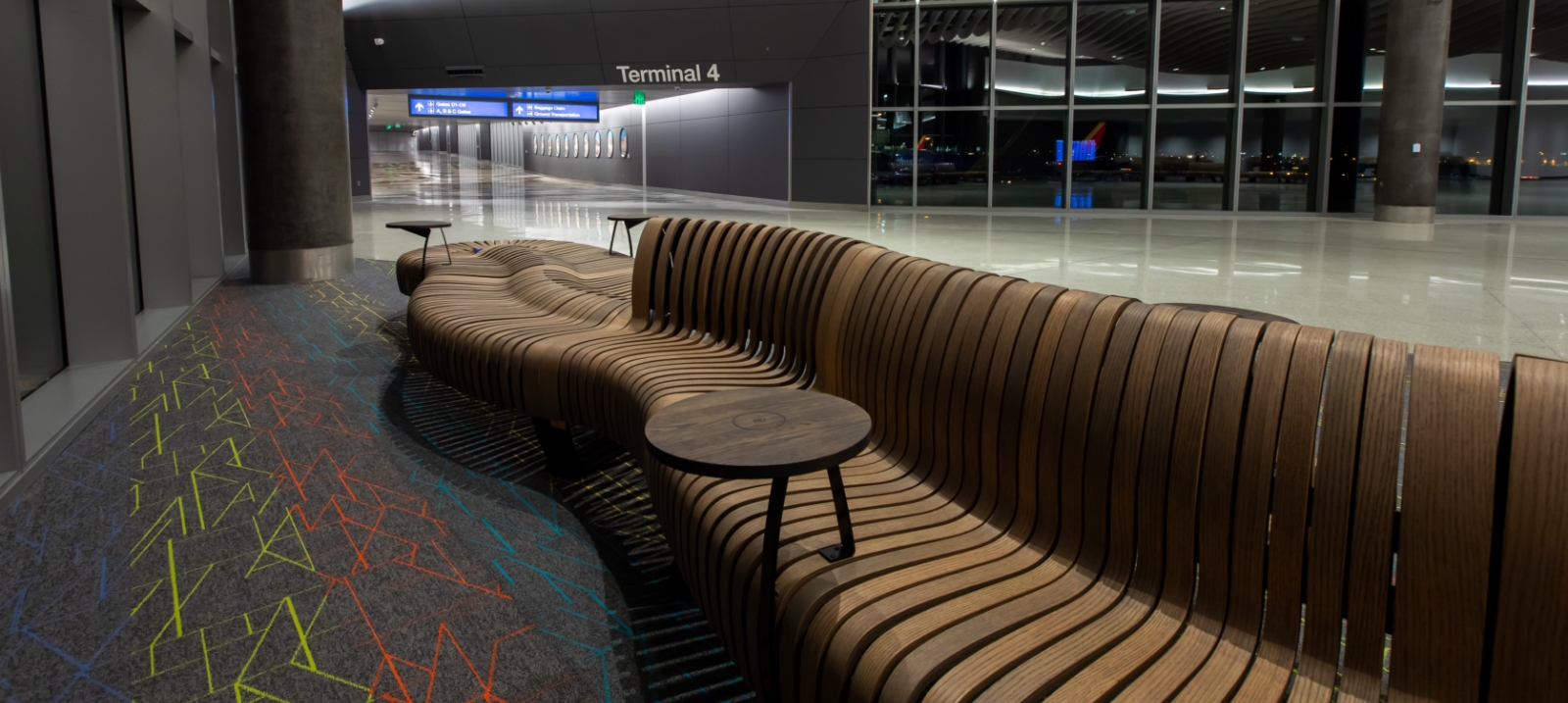Terminal 4 Museum Exhibitions
Terminal 4 Exhibitions
Earth and Sky
Fall 2022
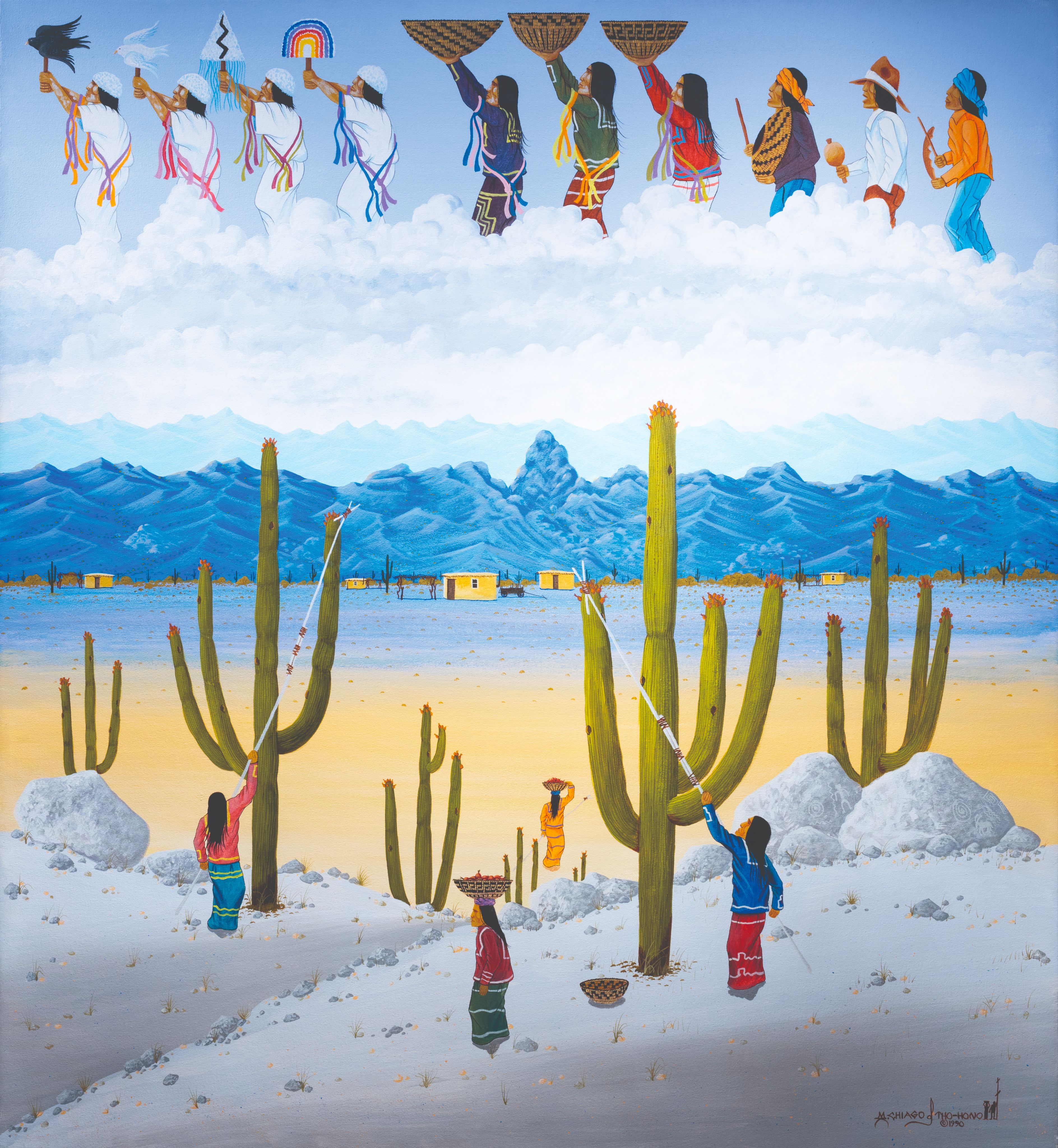
Michael Chiago Sr., Rain Dance and Saguaro Harvest, 1990, oil on canvas, Phoenix Airport Museum collection
Location
-
Terminal 4, level 3, gallery
Overview
Storytelling and artistic observation have always been used to make sense of the world and natural phenomena happening around us. Through a variety of mediums like paint, clay, fiber, ink, or photography, artists continue to seek and interpret the limitless beauty we can experience from our rocky planet.
Our fascination with the earth and sky has grown significantly with the aid of technology. Powered flight and telescopes have enabled us to explore the globe as well as space further, giving both scientists and artists new vantage points and perspectives.
This exhibition features 15 artists who look to nature for insight and inspiration. While some artists capture the rusty hues of geologic features, others illustrate the consistency of wispy or dense clouds in the atmosphere. A colorful sunset, dark storm, mountainous landscape, or flying are sometimes used as a metaphor for emotions such as optimism or rejuvenation. By interpreting the textures, colors, light, and symbolism we experience on our planet, this exhibition presents the wonder and connection we feel to Earth and Sky.
Featured Artists
Helen Burbank
Michael Chiago Sr.
Rebecca Davis
Jeff Falk
Susan Folwell
Adriel Heisey
Mark Klett
Ed Mell
Celia Alvarez Munoz
Jeffrey C. Perkins
Paula Jean Rice
Faith Ringgold
Carol Shinn
Clare Verstegen
Shelly White
Cast and Flame: Glass Art by Jennifer Caldwell and Jason Chakravarty
Through April 2023
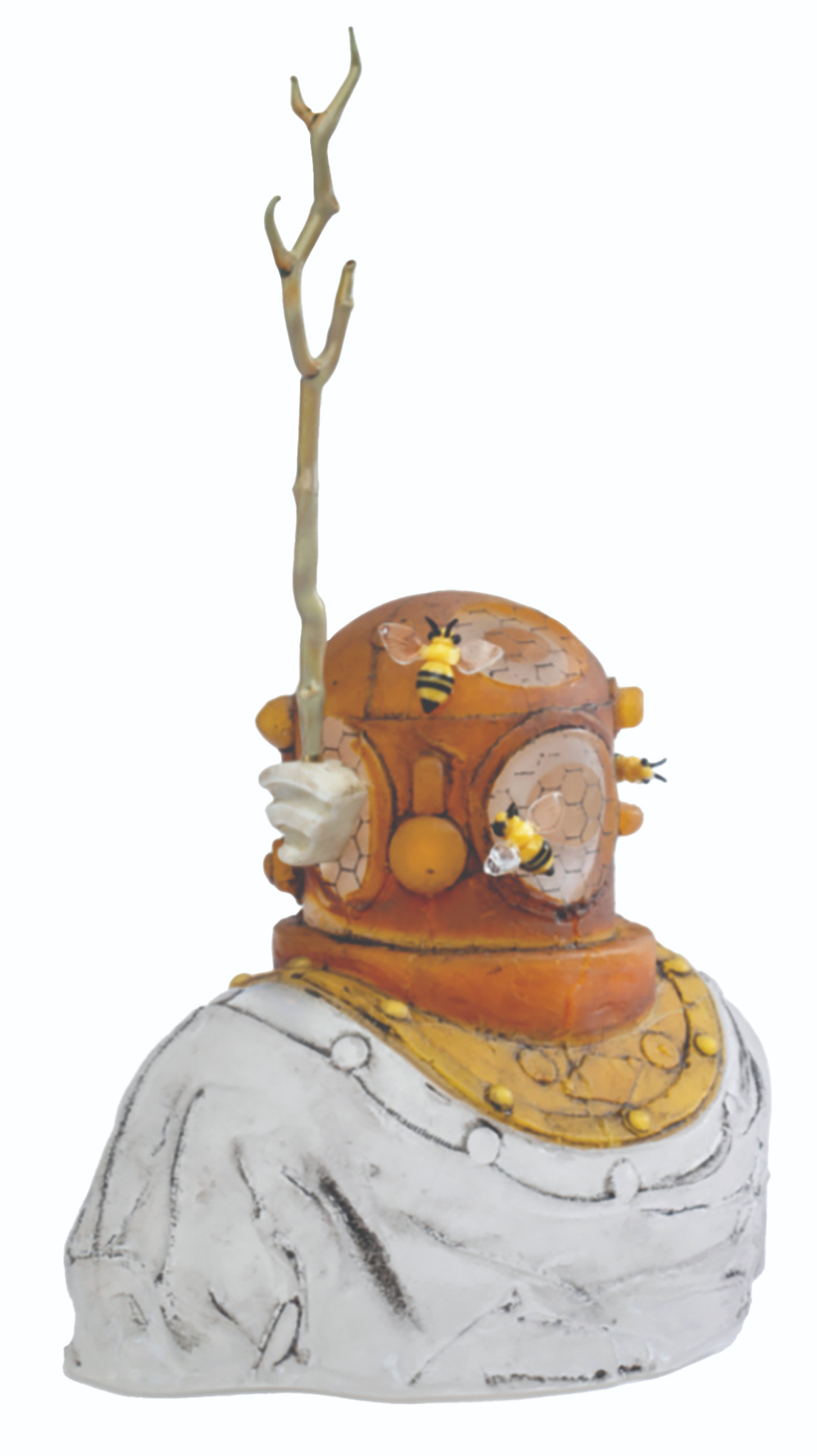
Jennifer Caldwell and Jason Chakravarty, Beecoming Connected, 2021, cast soda lime and flameworked borosilicate glass, courtesy of the artists
Location
-
Terminal 4, level 2, near the ticketing
Overview
Glass is a versatile material that can be manipulated in amazing ways. Its possibilities and surprises as an art form increase exponentially in the hands of two artists working collaboratively. Arizona artist couple Jennifer Caldwell and Jason Chakravarty, under the name JC Squared, combine their talents, ideas, and individual expertise to discover new and diverse ways of creating with glass.
Caldwell and Chakravarty, self-defined as “process junkies,” utilize a full spectrum of both hot and cold working techniques to cast, torch, blow, print, grind, cut, and blend glass. Their shared personal observations, life experiences, and travel fuel the flame of their work. Narrative-driven sculptures that explore the parallel relationships between humans and bees and vessels that reveal hidden underwater worlds offer a point of departure for the viewer to imagine different realities.
This exhibition presents glass artworks that are both playful in their application and nostalgic in their subject matter. Holding memories unique to the artists, they provide a glimpse into their lives and the ways they view the world. From barnacle-covered buoys to busy bees, Caldwell and Chakravarty creatively push the boundaries of what glass can become.
Western Perception
Through Summer 2022
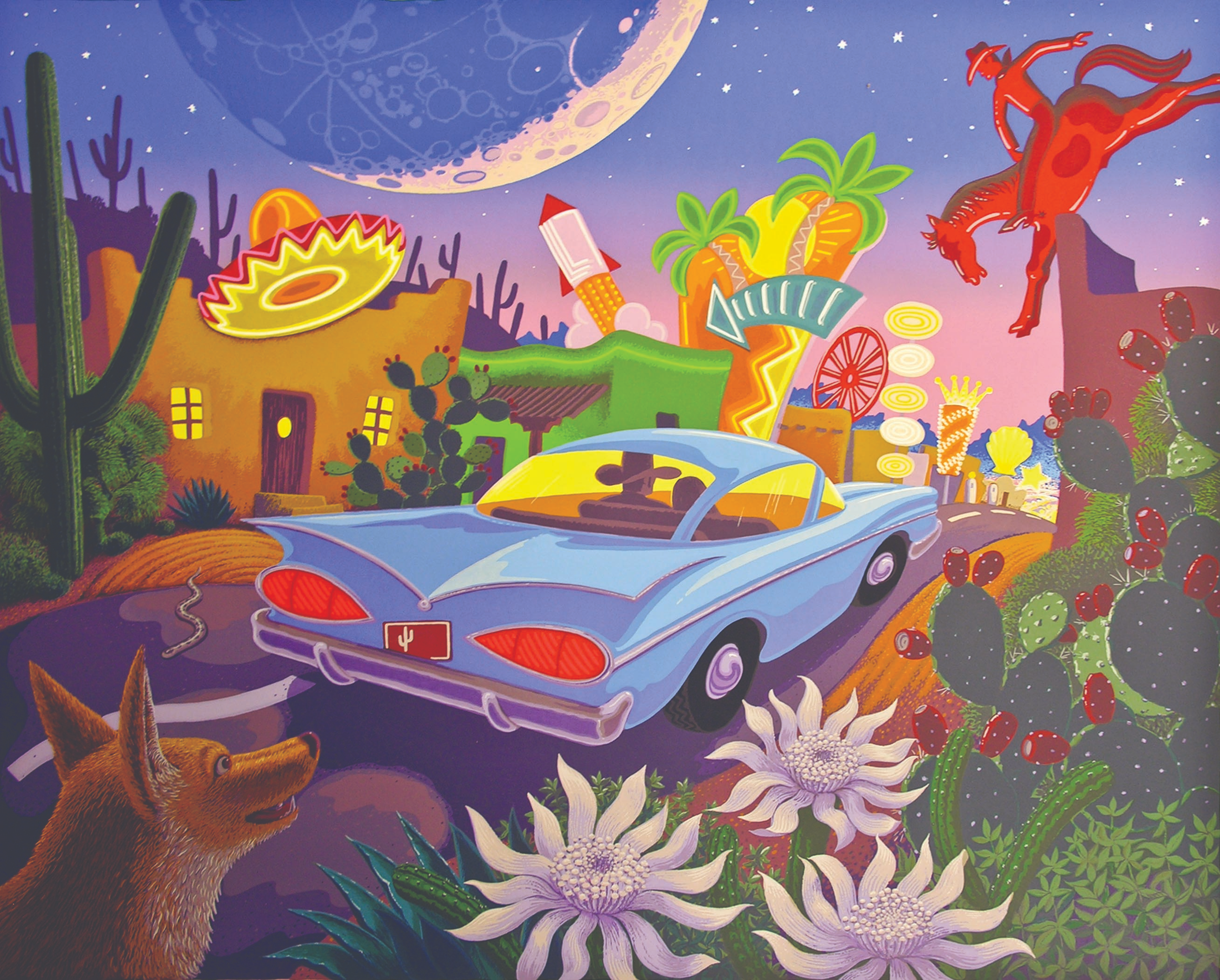
Stephen Morath, Arizona Noche, 1994, serigraphic print, Phoenix Airport Museum Collection
Location
-
Terminal 4, level 3, near the center (west of the food court)
Overview
A stereotypical view of the American West is not complete without courageous cowboys, lawless frontier towns, and a desolate desert. For more than a century, this idealized imagery of the region has been embellished upon and fabricated through film, literature, advertisements, and fine art. These romanticized visions and mythic tales of the “Old West” continue to cloud the truth about what life really looks like, even today, in Arizona and the Southwest.
This exhibition features 13 artists who both celebrate and challenge these depictions. Some artists create their interpretations of cowboys, cacti, and the desert climate to describe their experiences out West. Others use humor in their artwork to poke fun at exaggerated “Hollywood” portrayals. Whether based on fact or fiction, this exhibition highlights how popular culture has - and continues to - shaped our Western Perception.
Featured Artists
Shonto Begay
Anne Coe
Krista Elrick
Betty Hahn
William Jenkins
Luis Jimenez
Tamarra Kaida
Mark Klett
Muriel Magenta
Ed Mell
Stephen Morath
Linda Shearer-Whiting
Mark Zillman
From Studio to Street
Through July 2022
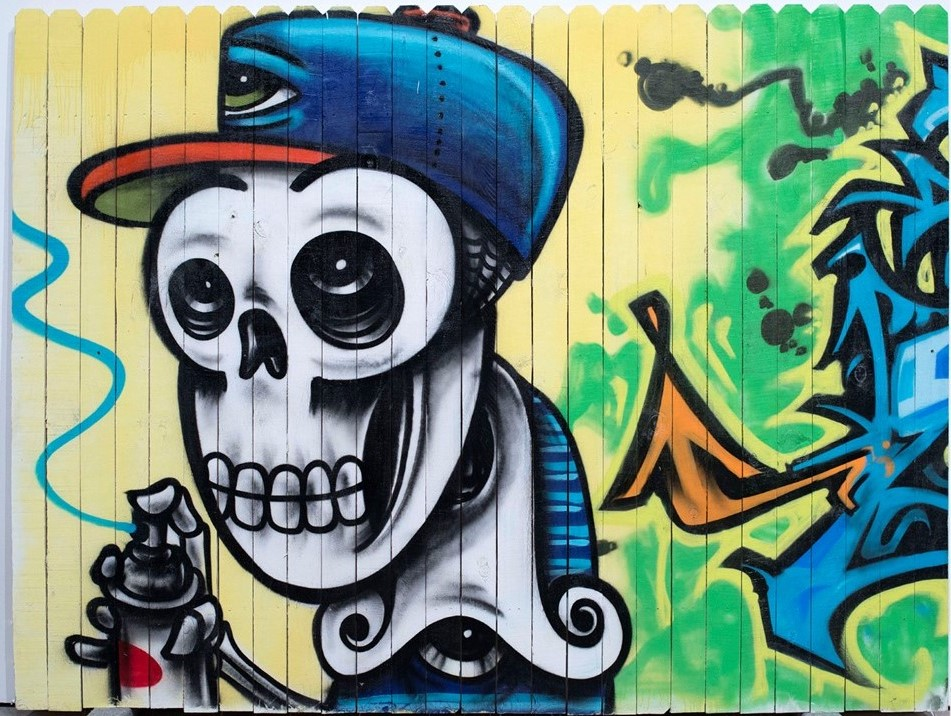
Lalo Cota, Untitled, 2015, spray paint on fence panel, 6 x 8', Courtesy of Scottsdale Museum of Contemporary Art, gift of the artists, "The Nitty Gritty Crew"
Location
-
Terminal 4, level 3, eight cases on the east and west ends
Overview
Once synonymous with tagging and urban decline, graffiti art has evolved into an art form that can now be viewed as an indicator of a city thriving with creativity. Street art has moved beyond stylized lettering and stencils to larger-than-life murals in every imaginable style, from abstract to photorealistic. Today, this immersive public art enlivens urban neighborhoods, creates a sense of place, and is accessible to everyone.
Here in Phoenix, artists armed with brushes, rollers, and spray cans are transforming featureless city blocks into artistic centerpieces. Once vacant walls now showcase painted murals in a variety of themes and styles that encourage people to visit, explore and interact with them. Technicolor sunsets, skulls, or Chicano lowriders all remind us of local culture and where we live. At the same time, other Phoenix murals pay homage to rock stars, promote social awareness, or present contemplative works of intricate patterns or surreal portraits.
This exhibition presents the work of nine artists who create in their studios as well as enhance our Phoenix streets with painted murals. Each of these artists has contributed their unique style and message to make the City more colorful and meaningful. Whether they began their artistic career painting on canvas or the side of a building, these artists take their art From Studio to Street.
Featured Artists
Brian Boner
Tato Caraveo
Lalo Cota
Maggie Keane
Kyllan Maney
Thomas "Breeze" Marcus
Carrie Marill
Such Styles and Champ Styles
Aviator Spotlight: Lincoln J. Ragsdale
Through January 2023
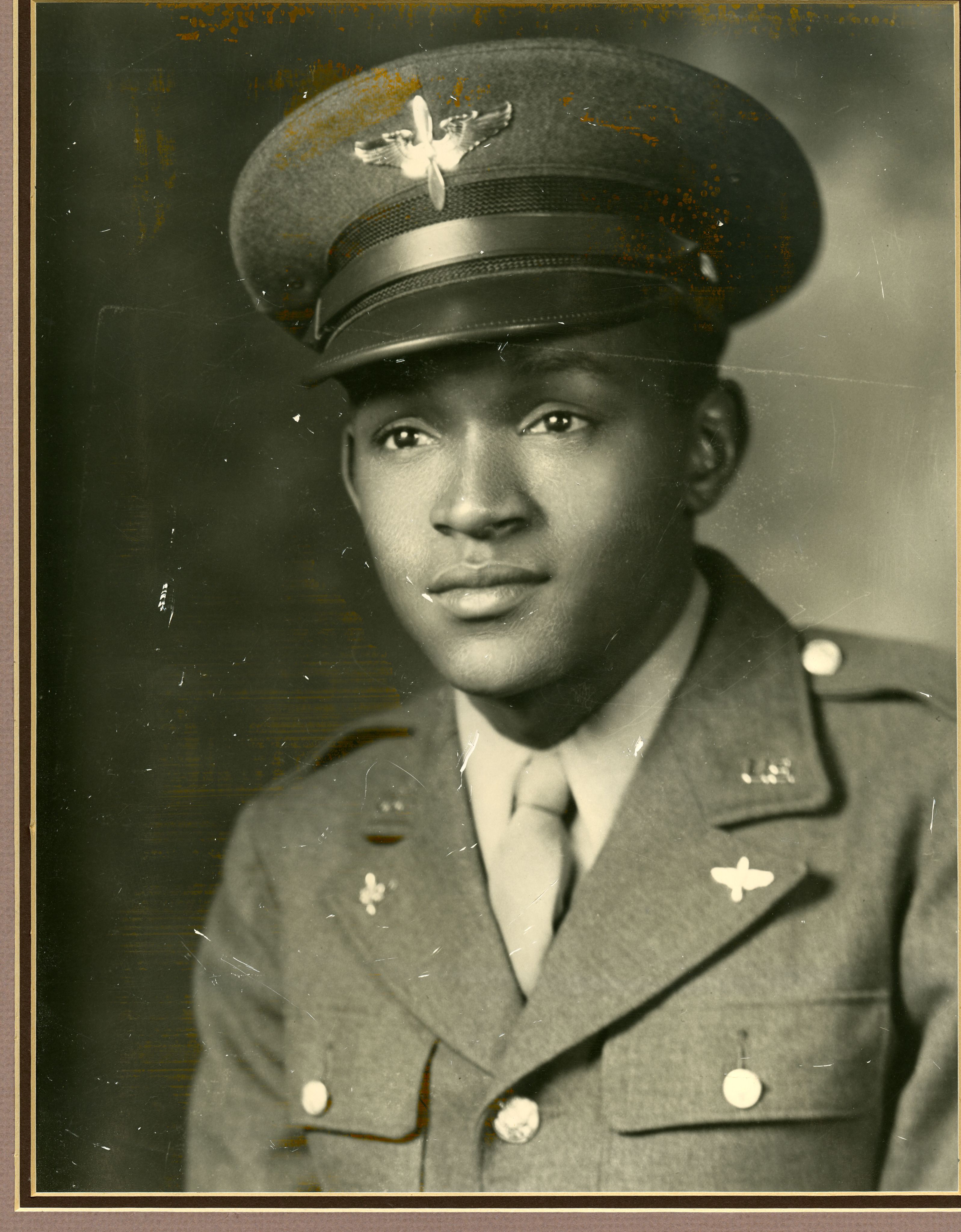
Location
-
Terminal 4, level 3, near the center escalator well
Overview
World War II created opportunities for black American men wishing to fly and serve their country. Lincoln Johnson Ragsdale Sr. seized the opportunity by becoming a member of the famed Tuskegee Airmen. He was also a civil rights activist, successful businessman, and respected community leader who persevered in the face of racial prejudice, discrimination, and exclusion, becoming one of Phoenix’s prominent and historical figures. His life was one of service, honor, and change.
Ragsdale was born in 1926 and raised in Oklahoma to a mortician father and a schoolteacher mother. The family business was a success, and the Ragsdale's lived more comfortably than most black families during the Great Depression. While attending a segregated high school, young Lincoln began to develop a love for flying. He regularly flew by paying a local pilot with money he had earned.
When Ragsdale graduated high school in 1944, he enlisted in the Army Air Force and trained to be a pilot at Tuskegee Institute in Alabama, becoming a member of the nation’s first all-African-American unit to fly for the U. S. Army Air Force. As part of the U.S. Army’s early integration effort, he wanted to refute the popular notion that blacks could not fly airplanes.
After the war, Ragsdale, a second lieutenant at the time, continued his military career as a member of an integrated gunnery unit stationed at Luke Air Force Base, Phoenix. He was one of the first black officers stationed there.
Ragsdale remained in Phoenix, becoming Arizona's first black funeral home owner in 1948, carrying on the family profession. In addition to the mortuary business, Ragsdale, an entrepreneur, had numerous other business ventures, including construction, a nightclub, insurance, ambulance service, and a flower shop.
As a community leader in the 1950s, Ragsdale championed civil rights and was instrumental in various reform efforts in Phoenix. He fought for the desegregation of schools, neighborhoods, and public accommodations. Ragsdale and his wife broke the color barrier by moving into an all-white neighborhood during a time when Phoenix was segregated. Despite being harassed and never fully accepted in their neighborhood, the couple lived in the home for 17 years and raised four children. The Ragsdale's became a local symbol of resistance to housing discrimination.
Ragsdale continued in aviation as a civilian pilot flying his private plane out of Sky Harbor for nearly four decades. He was a member of the Phoenix Aviation Advisory Board during the 1970s, where he played a key role in preserving general aviation services for small executive aircraft. In October 1995, the Phoenix City Council approved a proposal to rename the Sky Harbor Executive Terminal as the Lincoln J. Ragsdale Executive Terminal in honor of Ragsdale’s significant contributions to aviation in Arizona.
Movimiento Artístico del Río Salado (M.A.R.S)
Ongoing
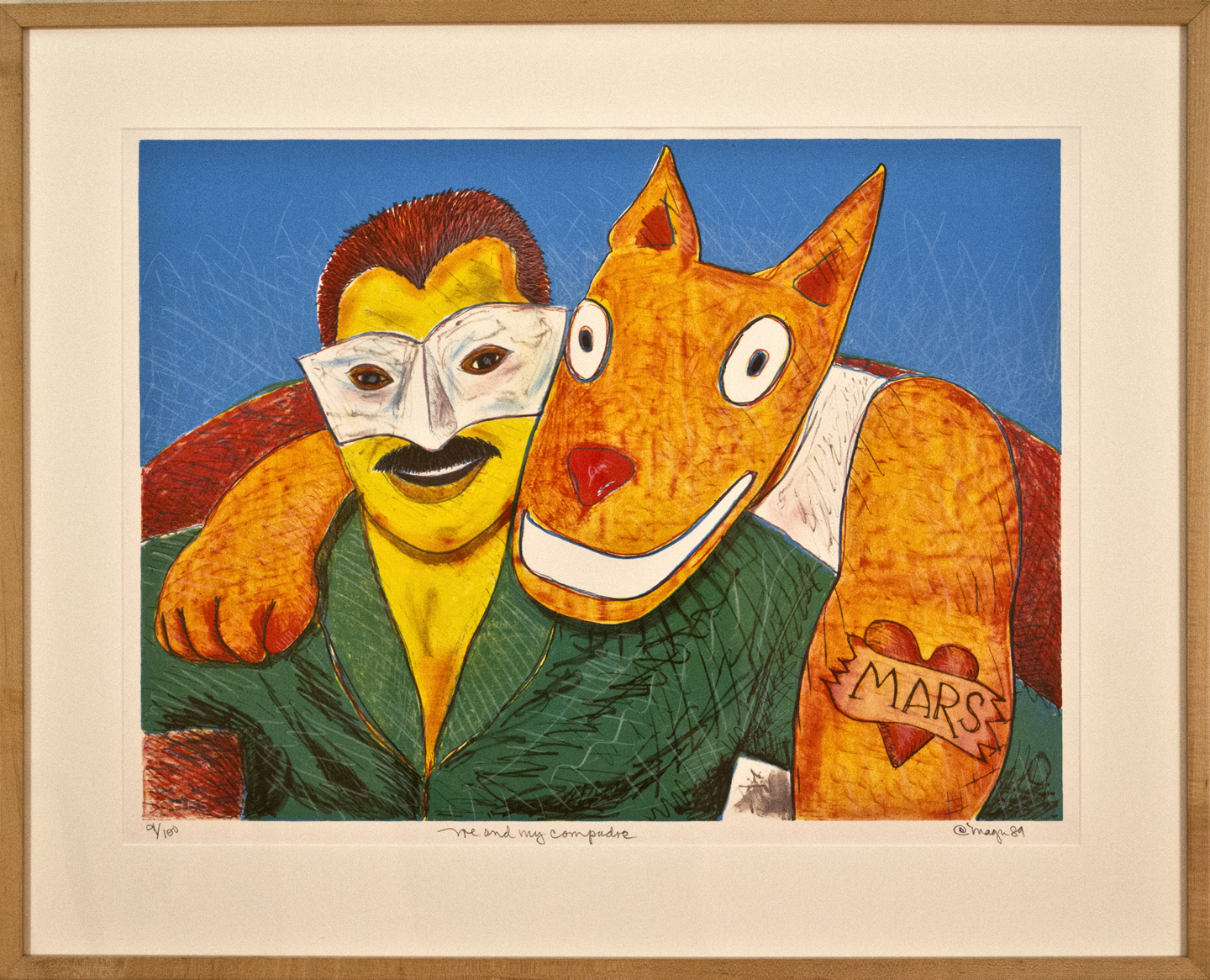
Gilbert “Magú” Lujan (1940-2011), Me and My Compadre, 1989, lithographic print, 30 x 37", Phoenix Airport Museum Collection
Location
- Terminal 4, level 3, near the center
Overview:
Movimiento Artístico del Río Salado (Art Movement of the Salt River), or M.A.R.S., was a non-profit visual arts organization founded in 1978 by a group of artists and community leaders. Its mission was to promote and support Mexican American and Chicano artists who otherwise felt restricted by commercial galleries.
In 1981, the artist collective opened a gallery in central Phoenix called M.A.R.S Artspace. The gallery featured rotating art exhibitions, artist-in-residence programs, and workshops - bridging the gap between the barrios and the rest of the city’s art community. During this time, M.A.R.S Artspace was the only Hispanic-operated gallery in Arizona. While the collective was dismantled in 2002, it paved the way for phICA (Phoenix Institute of Contemporary Art), which continues to help artists gain visibility and financial support.
This exhibition features artwork by four M.A.R.S. artists. These fine art prints were created in collaboration with Self Help Graphics of Los Angles, another community-based arts center serving Chicana/o and Latina/o communities. The resulting print series helped create a lasting legacy for M.A.R.S. and inspired the missions of numerous local art organizations today.
Featured Artists
Dolores Guerrero
César A. Martinez
Rudy Fernandez
Gilbert “Magú” Lujan
Hall of Flame: Museum of Firefighting in Phoenix
Ongoing
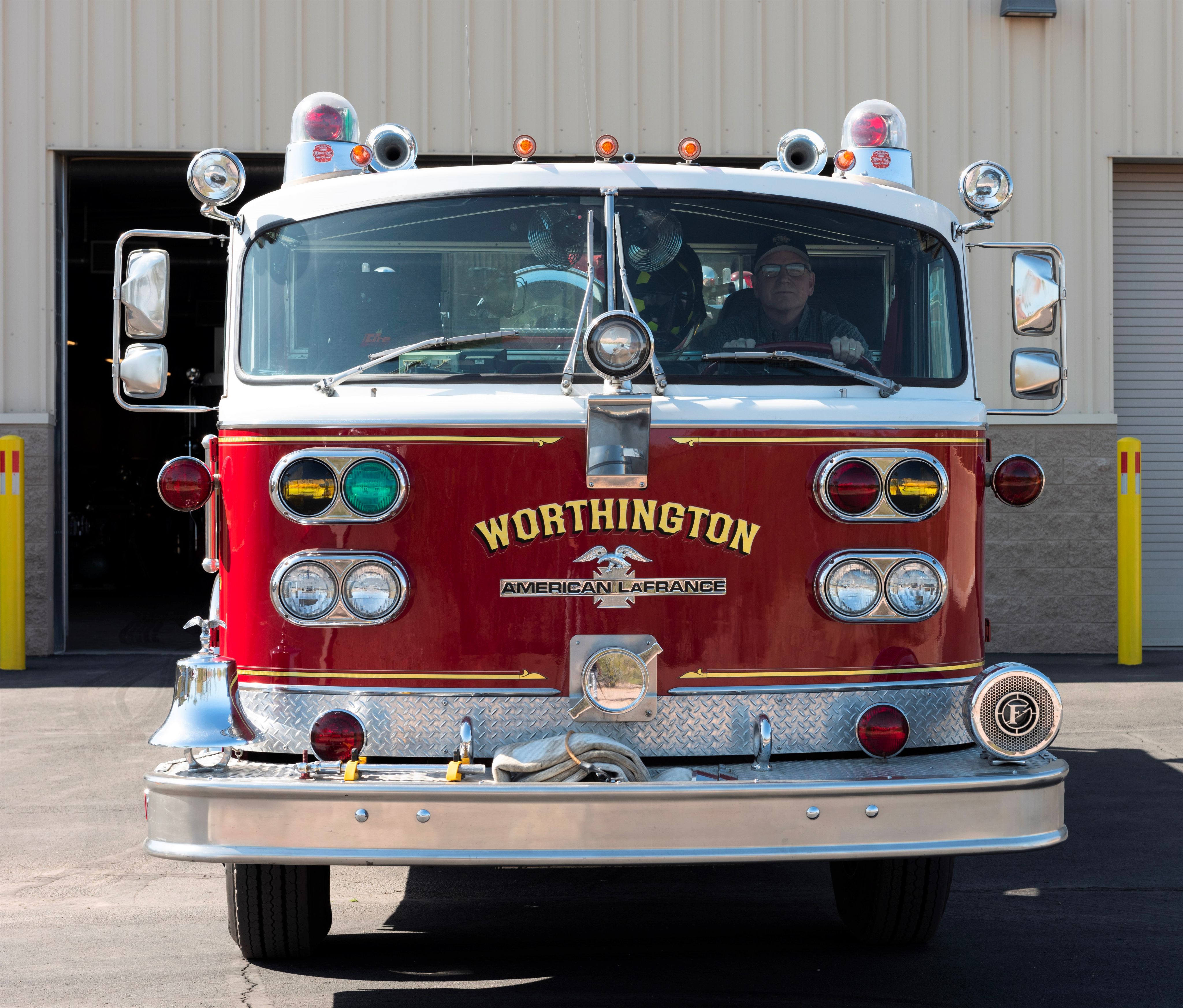
1977 Type 1000 (Century Series) manufactured by American LaFrance, Hall of Flame Museum collection, donated by Michael Worthington
Location
-
Terminal 4, level 3, near the center
Overview
The world’s largest firefighting museum, The Hall of Flame in Phoenix, began with a single Christmas gift. In 1955, George F. Getz, Jr. received a 1924 American LaFrance fire engine from his wife, Olive. This gift ignited Getz’s passion for collecting all things related to firefighting, and within five years, that obsession resulted in enough items to open a museum.
The Hall of Flame features a collection of historical objects from around the world representing three centuries of firefighting equipment. More than 130 firefighting rigs are on display, including manual, horse-drawn, and motorized apparatus. The Museum’s Hall of Heroes honors U.S. firefighters who have died in the line of duty and those recognized for acts of heroism. Other Museum highlights include a fire safety exhibition, a mini-theater, hands-on exhibits for children, and a vintage fire engine that visitors can board.
This exhibition of vintage helmets from around the world, speaking trumpets, fire buckets, and a handmade model of a fire engine is just a small preview of the extensive collections on display at the Hall of Flame Museum of Firefighting in Phoenix.

